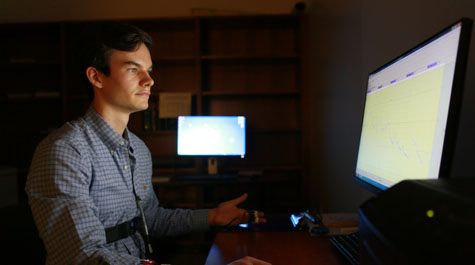Fear factor
William & Mary Assistant Professor of Psychology Chris Conway recalls a moment in his childhood in which he was chased by a neighbor’s aggressive dog. The experience didn’t scar Conway, but it did leave a lasting impression on someone else — his brother, who saw everything from afar.
“Ever since then he’s been afraid of dogs, and not just the neighbor’s dog, but all dogs,” he said. “His fear has become over-generalized.”
As Halloween approaches, it’s common for our deepest, darkest fears — of clowns, of spiders, of the creepy unknowns of a dark basement — to bubble to the surface. But many of these fears aren’t formed as a result of our own unsettling experiences. So how do they develop?
Conway, along with Alex Williams ’17, has an answer for that. It’s called vicarious fear learning, and it’s a phenomenon that explains why certain aversions are developed not from direct contact or experience, but simply by observing another’s reaction to the stimulus.
“As you can imagine there are beneficial evolutionary reasons that we develop fears vicariously,” said Conway. “We don’t need to eat every poisonous berry or interact with every fanged creature to know we shouldn’t do those things. The problem is when the anxiety from these fears occurs too intensely or in situations where it’s not objectively warranted.”
Conway and Williams are currently conducting a study that aims to find out if certain groups of people are more prone to fear contagion, particularly involving objects that aren’t explicitly dangerous or frightening.
“We want to know what specific personality traits can make them overly susceptible to acquiring fears of certain objects indirectly,” said Conway. “That will tell us who’s most at risk for being overly sensitive to cues of danger.”
Their research experiment puts participants in front of a computer screen and has them first watch a video of another supposed participant undergoing a test. The participant in the video is shown a series of shapes on a computer, one of which (a green cube) seems to consistently induce electric shocks and loud noises, causing the person in the video to react negatively.
Following the video, the participant in the lab is then hooked up to the same equipment and is told they will undergo the same experiment. As the shapes — including the seemingly sinister green cube — appear on the screen, Conway and Williams are monitoring the participant’s self-reported sense of whether threat is imminent, as well as the physiological responses that could signal fear.
“We’re measuring the skin conductance response, or sweating on the fingers, which is the same type of measurement that’s used in a polygraph test,” said Williams. “It’s a way you can measure arousal, and in this case arousal would mean fear.”
Prior to the experiment, participants are also asked to fill out a questionnaire that self-evaluates their levels of certain personality traits, most importantly generalized anxiety and empathy, which Conway and Williams hypothesize have the most direct effect on susceptibility to learned fears.
“In this case empathy means paying very close attention and being attuned to the reactions of the demonstrator,” said Conway. “So if someone was at the very low extremes of empathy — like psychopaths typically are, for example — they would care very little about what the other person is going through and they wouldn’t pick up on the predictive relationship between the images on the screen and shocks the person receives.”
A person with high levels of anxiety, on the other hand, might be hyper-vigilant toward potential threats in the environment, even when there’s no evidence that a threat exists.
“We expect that people who are prone to anxiety will show larger skin conductance responses to the green cube when it’s presented, and maybe even larger responses to the other shapes, or safety cues,” said Conway. “People with high anxiety will often generalize fears, just like my brother over-generalized his fear to all dogs.”
As Williams leads the project in the lab, Conway is imagining future applications of the test, potentially on patients (particularly those with severe anxiety and very low empathy) at a local psychiatric hospital, which could provide more evidence that their experiment is effective in measuring susceptibility to vicarious fear learning.
“If we were to learn that this is an accurate test for measuring who’s vulnerable to developing fears indirectly, then we would be able to know when somebody’s environment is especially relevant to their fear development,” said Conway. “You could advise parents of more susceptible children, for example, that their reactions to X, Y or Z can be more easily transmitted indirectly to their children.”
















